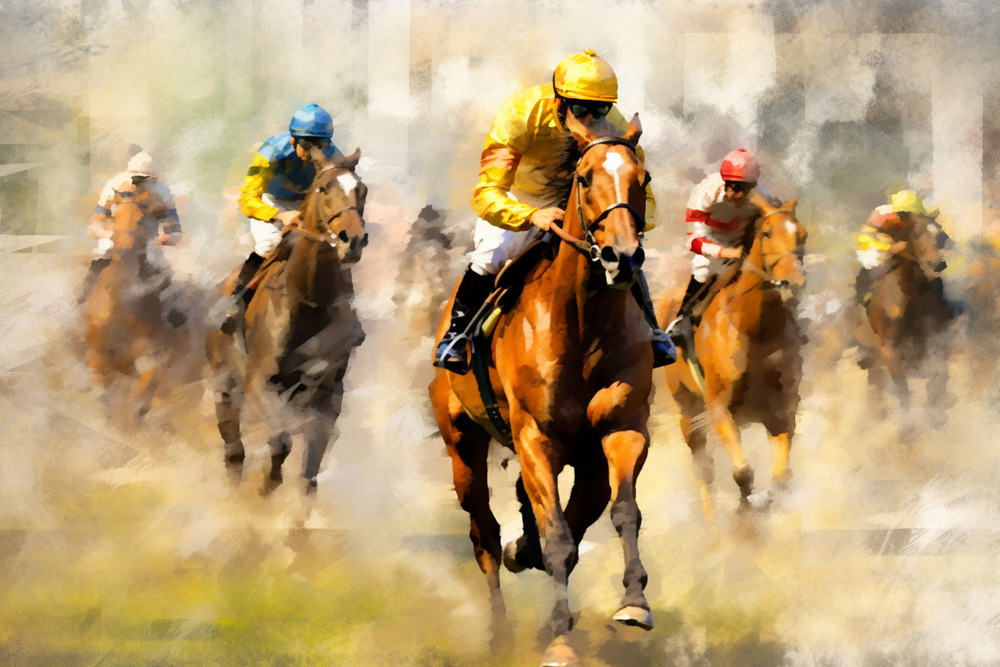When aiming to enhance your horse racing betting strategies, understanding speed figures can be an essential component. These figures provide a standardized assessment of a horse’s past performance, allowing for more effective comparison among competitors. They are not merely raw numbers; the ability to analyze race data and factor in elements such as track conditions is crucial.
Calculating speed figures typically involves adjusting a horse’s finishing time based on the speed of the track on a given day, offering a more reliable measure of performance across different races.
To effectively utilize speed figures in your betting strategy, it is important to consider the context in which they were achieved. This includes evaluating the conditions of the track, distance of the race, and the level of competition.
By doing so, bettors can gain insights into a horse’s potential performance in future races. Employing speed figures as part of a comprehensive analysis can potentially improve wagering outcomes by providing a more informed basis for decision-making.
Key Takeaways
- Speed figures offer a standardized method to compare horse speeds across different races and conditions, aiding in informed betting decisions.
- Analyzing recent speed figures helps assess current performance levels and predict future race outcomes.
- Consistent high speed figures indicate reliability and competitiveness, key for identifying strong contenders.
- Consider track conditions and race distances when using speed figures to ensure accurate horse comparisons.
- Combine speed figures with other metrics like jockey and trainer statistics for a comprehensive betting strategy.
Understanding Speed Figures
Speed figures are numerical ratings that evaluate a horse’s performance in a race. They’re important in horse racing betting because they offer a standardized method to compare the speeds of horses across different races, tracks, and conditions. This enables bettors to make more informed decisions based on objective data rather than subjective opinions.
Key aspects of speed figures include:
-
Standardization: Speed figures account for variations in track conditions and other factors, allowing for an accurate comparison of performances from different races and tracks.
-
Historical Data: These figures are based on past performances, providing a detailed overview of a horse’s racing history.
-
Predictive Value: Analyzing speed figures can help predict future performance, which is valuable for making informed betting choices.
Understanding speed figures allows bettors to:
-
Identify Strong Contenders: Quickly identify high-performing horses without the need for extensive research.
-
Evaluate Improvements: Recognize horses that show progress over time, which may indicate potential future success.
-
Assess Competition: Compare horses competing in the same race to assess their relative strengths.
Dive deeper into the topic by reading our article Understanding Pace and Speed Ratings in Horse Racing Betting.
Calculating Speed Figures
Understanding how speed figures are calculated is essential for analyzing horse racing performance. Speed figures offer a quantitative assessment of a horse’s race outcome by taking multiple factors into account. Below is a detailed explanation of the calculation process:
-
Race Time: The horse’s finishing time is the foundation of speed figures. Precise timing is necessary to ensure the figures’ accuracy and dependability.
-
Track Conditions: The condition of the track, such as whether it’s fast, sloppy, or muddy, is a critical factor. Track conditions can significantly affect a horse’s speed and, consequently, the speed figure.
-
Distance: The race distance must be considered, as speed figures are typically standardized to a particular distance. Adjustments are made for longer or shorter races to maintain consistency in the figures.
-
Pace of Race: The pace at which the race is run can influence the horse’s finishing time. A fast-paced race could result in a slower final time due to early exertion, whereas a slower pace might enable a quicker finish.
-
Class Level: The level of competition is another critical adjustment factor. A horse running against high-quality competitors may exhibit different performance characteristics compared to when competing against lower-tier horses.
Overall, speed figures are derived by systematically evaluating these components to provide a comprehensive measure of a horse’s racing performance.
This analytical approach enables bettors and enthusiasts to make informed decisions based on objective data.
Analyzing Race Data
When analyzing race data, it’s important to identify patterns and trends that can provide insights into a horse’s potential performance.
Begin by reviewing past race results to understand how a horse has performed under various conditions. Consider the following factors:
-
Race Conditions: Examine the track surface and distance for each race. Horses may have preferences and perform better on certain surfaces or over specific distances.
-
Race Times: Evaluate the times recorded in each race. Faster times suggest better performance, but it’s crucial to compare these times to those of other horses in the same race to gain context.
-
Positioning: Record the starting and finishing positions. Horses that consistently finish strong may have good stamina, while those that start strong but fade may lack endurance.
-
Weather Conditions: Weather can impact track conditions and, consequently, performance. A horse that performs well on a wet track mightn’t do as well on a dry one.
-
Consistency: Horses that show consistent performances across different races are typically more reliable indicators of future performance.
Comparing Competitors
When comparing competitors in horse racing, a methodical evaluation of each horse’s strengths and weaknesses is essential for making informed betting decisions.
Begin by analyzing the speed figures for each horse participating in a race. These figures provide insights into how fast a horse has run in previous races, facilitating a comparison of its performance relative to others.
Key factors to consider include:
-
Consistency: Identify horses that consistently achieve high speed figures, as this suggests reliability and an increased likelihood of strong performance.
-
Track Conditions: Evaluate how each horse performs under varying track conditions. Some horses have a preference for muddy tracks, while others perform better on dry surfaces.
-
Distance Specialization: Determine which horses excel at the specific race distance. Some horses may perform well in short sprints but face challenges in longer races.
-
Recent Form: Examine the horse’s recent race history. A horse that has been on a winning streak or has shown improvement may be a strong candidate for success.
Additionally, assess the influence of jockeys and trainers. Experienced jockeys can positively affect a horse’s performance, while trainers with a history of producing winning horses can also be a significant factor.
Applying Speed Figures
To apply speed figures in horse racing bets effectively, integrate them into your overall betting strategy. Speed figures offer a numerical representation of a horse’s past performance, enabling an assessment of its speed in previous races. By analyzing these figures, you can make informed predictions about a horse’s potential in upcoming races.
Here’s a structured approach to applying speed figures:
-
Comparison: Utilize speed figures to compare horses in the same race. Identify patterns that indicate consistent performance or improvement over time.
-
Track Conditions: Take into account the track conditions when the figures were recorded, as a horse may perform differently on various surfaces, such as dirt or turf.
-
Distance Suitability: Analyze how a horse’s speed figures vary with different race distances. Some horses may exhibit better figures at specific lengths.
-
Recent Performance: Prioritize recent speed figures, as they provide a more accurate reflection of the horse’s current form.
-
Class Level: Assess speed figures within the context of the race’s class level. Higher class races typically demand superior figures for a horse to remain competitive.
Enhancing Betting Strategies
A comprehensive betting strategy should encompass more than just evaluating speed figures. To refine your approach, consider integrating the following elements:
-
Track Conditions: Monitor weather and track conditions, as they can have a substantial effect on a horse’s performance. For instance, a horse that performs well on a muddy track may not achieve the same results on a dry surface.
-
Jockey and Trainer Performance: Examine the historical performance of jockeys and trainers. Certain combinations may have a stronger track record together, and some trainers might specialize in preparing horses for specific types of races.
-
Post Position: The starting gate position can affect a horse’s race. For example, horses starting from inside gates might’ve an advantage in shorter races, whereas outside gates could be beneficial in longer races.
-
Recent Form: Assess a horse’s recent performances. A horse that consistently finishes near the top is likely to be in optimal form and may be a competitive contender.
-
Class and Competition: Evaluate the level of competition a horse has previously faced. A horse moving up in class may encounter challenges when competing against stronger opponents.
Frequently Asked Questions
How Do Weather Conditions Affect a Horse’s Speed Performance in Races?
Weather conditions significantly impact a horse’s speed. Rain can make tracks slippery, affecting footing and speed. Wind can hinder progress or provide a boost, depending on its direction. You should always consider these factors when evaluating performance.
Are There Specific Tracks Where Speed Figures Are More Reliable?
Yes, some tracks consistently produce more reliable speed figures. You should consider factors like track surface and maintenance. Tracks with consistent conditions usually offer more dependable data, allowing you to make informed decisions when placing bets.
Can Jockey Experience Impact the Consistency of Speed Figures?
You should consider jockey experience as it can indeed impact speed figures’ consistency. Experienced jockeys often manage the race pace better, optimizing a horse’s performance, which can lead to more reliable and consistent speed figures over time.
What Role Does a Horse’s Age Play in Speed Figure Accuracy?
A horse’s age influences speed figure accuracy because younger horses are still developing, leading to inconsistent performance. As the horse matures, you’ll see more consistent figures. Keep an eye on age to adjust your betting strategy accordingly.
How Should Layoff Periods Be Factored Into Speed Figure Evaluations?
Consider layoff periods by analyzing how they impact a horse’s performance. Check past races after breaks to see patterns. Long layoffs might indicate decreased speed, while shorter ones could suggest a fresher, potentially faster horse on the track.
Conclusion
Incorporating speed figures into your horse racing bets can significantly enhance your decision-making. By understanding and calculating these figures, you can effectively analyze race data and compare competitors. This process allows you to:
- Assess recent form
- Evaluate jockey and trainer statistics
- Adjust for race class levels
Ultimately, using speed figures helps you make more informed bets, increasing your chances of success. Keep refining your strategies, and you’ll become a more savvy bettor.

